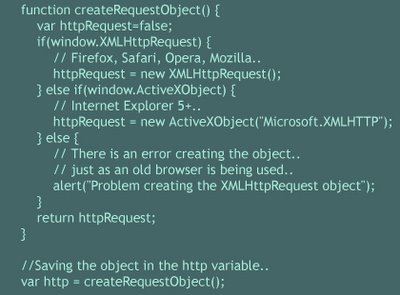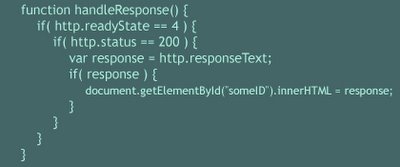What is Lorem Ipsum?
Why do we use it?
Where does it come from?
and more @
http://gr33ndata.blogspot.com/2006/08/lorem-ipsum.html
<? adjuster ?>








 Like Google? Like Yahoo?
Like Google? Like Yahoo? Google gave journalists a glimpse of its next generation machine translation system at a May 19th Google Factory Tour. The system has been trained using the United Nations Documents as a corpus. This corpus is some 200 billion words worth of content. It uses existing source and target language translations (done by human translators at the U.N.) to find patterns it then uses to build rules for translating between those languages. Apparently it was successful where the current version had failed in translating certain phrases. If anyone were capable of making a serious go of MT, that would have to be Google..
Google gave journalists a glimpse of its next generation machine translation system at a May 19th Google Factory Tour. The system has been trained using the United Nations Documents as a corpus. This corpus is some 200 billion words worth of content. It uses existing source and target language translations (done by human translators at the U.N.) to find patterns it then uses to build rules for translating between those languages. Apparently it was successful where the current version had failed in translating certain phrases. If anyone were capable of making a serious go of MT, that would have to be Google.. A friend of mine has a PDA..
A friend of mine has a PDA.. Yesterday June 04, 2006 i did my interview as a real estate agent..
Yesterday June 04, 2006 i did my interview as a real estate agent..I couldn't blog in May because of a very annoying problem..
My DSL connection was terrible and having 200% problems..
I couldn't connect to the web, read or send my emails, read my feeds or even blogging..
After alot of investigations, i discovered that the DSL Provider company and the Router MisConfiguration is the key elements behind this problem..
The problem is still current, but will be solved in the very near future..
 The terms dark internet or dark address refer to any or all of the unreachable network hosts on the internet.
The terms dark internet or dark address refer to any or all of the unreachable network hosts on the internet.The Internet <does not equal> The Web..
The Internet and the Web are not synonymous..
The Web is a term that's often mistakenly used as a synonym for the Internet itself.. but here's the distinction between them:
-The Internet:
The Internet, or simply the Net, is the publicly accessible worldwide system of interconnected computer networks that transmit data by packet switching using a standardized Internet Protocol (IP). It is made up of thousands of smaller commercial, academic, domestic, and government networks. It carries various information and services, such as electronic mail, online chat, and the interlinked Web pages and other documents of the World Wide Web..
The Internet is a collection of interconnected computer networks, linked by copper wires, fiber-optic cables, wireless connections, microwave links etc..
-The Web:
The World Wide Web ("WWW" or simply the "Web") is a global information space which people can read-from and write-to via a large number of different Internet-connected devices. For example, computers, Personal Digital Assistants(PDA), cellular phones, telephone kiosks, etc. The World Wide Web is also available (sometimes only partially) through digital television services, exposing content onto television screens..
The Web is actually a service that operates over the Internet, just like e-mail..
WWW is the complete set of documents residing on all Internet servers that use the HTTP protocol, accessible to users via a simple point-and-click system..
The Web is a collection of interconnected documents, linked by hyperlinks and URLs, and is accessible using the Internet..
On other words we can say:
The Internet is the hardware..
The Web is the software..
<.adjuster />
 Woohoo, i'm a contributor now in meebo Arabic translation..
Woohoo, i'm a contributor now in meebo Arabic translation.. Second, we need to write an event handler which will be called via some event on our user's page, and will handle sending our request for data to our server.
Second, we need to write an event handler which will be called via some event on our user's page, and will handle sending our request for data to our server.
The event handler will use various methods of our XMLHTTPRequest object to:
-- Make the request to the server..
-- Check when the server says that it has completed the request..
-- Deal with the information returned by the server..
We can make our request of the server by using a GET method to an appropriate server-side script. Here's an example event handler called sendRequest which assumes that we have created our XMLHTTPRequest object and called it http: Note that the function listens to the onreadystatechange property of the XMLHTTPRequest object and, each time this parameter changes, calls a further function handleResponse..
Note that the function listens to the onreadystatechange property of the XMLHTTPRequest object and, each time this parameter changes, calls a further function handleResponse..
Third, then, we need to write a function handleResponse which will establish when the server has completed our request, and do something useful with the data it has returned: Note here that our function checks for a readyState value of 4 - there are various numbered states describing the progress of such a request, but we are only interested in the value of 4, which indicates that the request is complete and we can use the returned data.
Note here that our function checks for a readyState value of 4 - there are various numbered states describing the progress of such a request, but we are only interested in the value of 4, which indicates that the request is complete and we can use the returned data.
Also we check that a successful server response was received.. that's 200..
In this case, we have received our information as simple text via the responseText property of our XMLHTTPRequest object. Information can, however, be returned as XML or as properties of a predefined javascript object, though this is perhaps beyond the scope of this tutorial.
This creates a request object along with a send request and handle response function. So to actually use it, you could include the previous JavaScript functions in your page. Then to make one of these backend requests you would tie it to something. Like an onclick event or a straight href like this: That means that when someone clicks on that link what actually happens is that a backend request to
That means that when someone clicks on that link what actually happens is that a backend request to
( somepage.php?id=getserverdata ) will be sent.
Now, let's get to the server-side part "somepage.php", you might have something like this: Now, look at handleResponse. It assigns the string returned by the server "Hello AJAX World" to the ID named someID using DOM..
Now, look at handleResponse. It assigns the string returned by the server "Hello AJAX World" to the ID named someID using DOM..
That means if you have a DIV tag like this in your page: Once you click on that link, that will dynamically be changed to:
Once you click on that link, that will dynamically be changed to: That's all there is to it. Everything else is just building on top of this. Replacing the simple response "Hello AJAX World" syntax with a richer XML format and making the request much more complicated as well. Before you blindly install large "AJAX" libraries, have a go at rolling your own functionality so you know exactly how it works and you only make it as complicated as you need. Often you don't need much more than what is shown here.
That's all there is to it. Everything else is just building on top of this. Replacing the simple response "Hello AJAX World" syntax with a richer XML format and making the request much more complicated as well. Before you blindly install large "AJAX" libraries, have a go at rolling your own functionality so you know exactly how it works and you only make it as complicated as you need. Often you don't need much more than what is shown here.
<.adjuster />